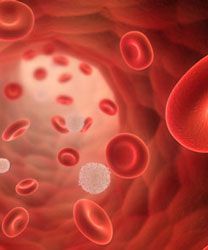Chemo/Radioimmunotherapy Treatment Strategy Induces 90% PFS at 3 Years in Follicular Lymphoma
Combining consolidative radioimmunotherapy and sequential maintenance rituximab following chemoimmunotherapy improved progression-free survival at 3 years in patients with previously untreated follicular lymphoma, according to findings from the phase II SWOG S0801 study recently published in <em>The Lancet Hematology</em>.
blood cells

Combining consolidative radioimmunotherapy and sequential maintenance rituximab (Rituxan) following chemoimmunotherapy improved progression-free survival (PFS) at 3 years in patients with previously untreated follicular lymphoma, according to findings from the phase II SWOG S0801 study recently published inThe Lancet Hematology.
In the single-arm study, patients received a 5-year treatment plan of consolidative radioimmunotherapy plus sequential maintenance rituximab following R-CHOP chemoimmunotherapy.
“For patients with follicular lymphoma enrolled in our trial, sequential R-CHOP, radioimmunotherapy, and maintenance rituximab resulted in excellent treatment responses and durability of these responses,” the study authors wrote in their published findings.
Treatment consisted of 750 mg/m2of cyclophosphamide, 50 mg/m2of doxorubicin, and 1.4 mg/m2of vincristine intravenously on day 1, with 100 mg of oral prednisone or prednisolone daily for days 1 to 5 plus 375 mg/m2of rituximab on day 1 of cycles 1 to 4. R-CHOP was administered every 21 days for up to 6 cycles. Within 12 weeks after the sixth cycle of R-CHOP, subsequent131iodine tositumomab radioimmunotherapy was given and 375 mg/m2of maintenance rituximab every 3 months for up to 4 years.
Patients had stage III, IV, or bulky stage II follicular lymphoma, grades 1, 2, or 3a. The median age among enrolled patients was 52 (range, 46-60) and 52% were female. The majority (62%) of patients had an ECOG performance status of 0. Twenty-four percent of patients had bulky disease (>10 cm) and 62% had bone marrow involvement. Four-two percent had a high-risk as perceived by a high FLIPI (Follicular Lymphoma International Prognostic Index) score, and 40% had medium risk. Patients were recruited from 20 different institutions within the United States National Cancer Institute Clinical Trials Network.
Of the 84 patients enrolled in the study, 73 completed R-CHOP and radioimmunotherapy treatment. Sixty-nine of the 73 patients received the sequential rituximab maintenance therapy, with 54 patients completing 2 years and 41 patients completing the full 4 years of treatment. Patients were removed from protocol treatment for progressive disease, unacceptable toxicity, or patient preference.
Dose modification of R-CHOP was required in 42% and 9% required dose modification of maintenance rituximab. Maintenance therapy was discontinued in 28 patients.
The primary endpoint of the phase II study was progression-free survival (PFS) after 3 years. Secondary endpoints included PFS after 5 years, overall survival (OS) after 5 years, response rate up to 7 years on protocol or time of disease progression, and safety profile.
The PFS was analyzed in the intention-to-treat population. At 3 years, the PFS was 90% (95% CI, 82%-95%) and 85% at 5 years (95% CI, 75%-91%). OS estimates at 3 years were 96% (95% CI, 89%-99%) and 94% at 5 years (95% CI, 86%-98%). Patients with low or intermediate FLIPI scores tended to have significantly better PFS rates than patients with high FLIPI scores (98% vs 80%, respectively;P= .005).
The most common adverse events of grade 3 or higher during R-CHOP and radioimmunotherapy consolidation were neutropenia (57%), leucopenia (40%), thrombocytopenia (20%), and febrile neutropenia (17%). With maintenance therapy, the most common grade 3/4 adverse event was lymphopenia in 6%. Nine patients had possible treatment-related deaths for secondary or unknown causes in 3 cases, and cirrhosis, cardiac arrest, and secondary malignancies in 1 case each. Secondary malignancies occurred in 7 patients, including 2 sarcomas, 2 colorectal carcinomas, 2 acute myelogenous leukemias, and 1 renal cell carcinoma.
While sequential R-CHOP, consolidative radioimmunotherapy, and maintenance rituximab induced favorable outcomes, the full treatment plan was not followed by a considerable proportion of patients. This suggests that treatment decisions should be made on a case-by-case basis.
The study authors noted that further study is needed to enable clinicians to determine the adequate balance of chemoimmunotherapy and post-induction strategies in patients with follicular lymphoma, “maintenance therapy beyond 2 years and maintenance of any duration following bendamustine might require further study before routine adoption.”
Reference:
Barr PM, Li H, Burack WR, et al. R-CHOP, radioimmunotherapy, and maintenance rituximab in untreated follicular lymphoma (SWOG S0801): a single-arm, phase 2, multicentre study [published online January 24, 2018].Lancet Haematol.doi: 10.1016/S2352-3026(18)30001-2.
Lachowiez Considers the Use of Tagraxofusp in BPDCN as Bridge to SCT With Peers
March 21st 2024During a Targeted Oncology™ Case-Based Roundtable™ event, Curtis Lachowiez, MD, discussed targeted therapy for blastic plasmacytoid dendritic cell neoplasm and its role in patients who could receive allogeneic stem cell transplant.
Read More